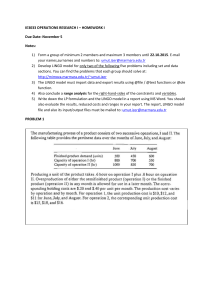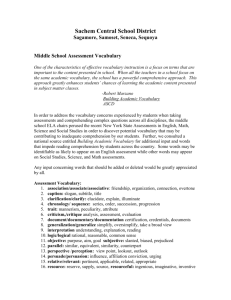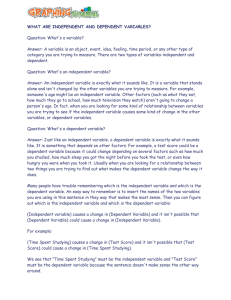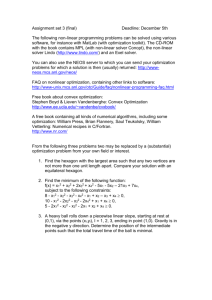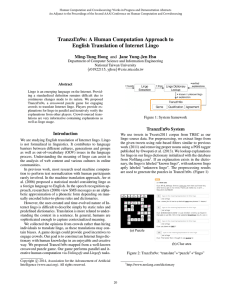to solve current problem set
advertisement
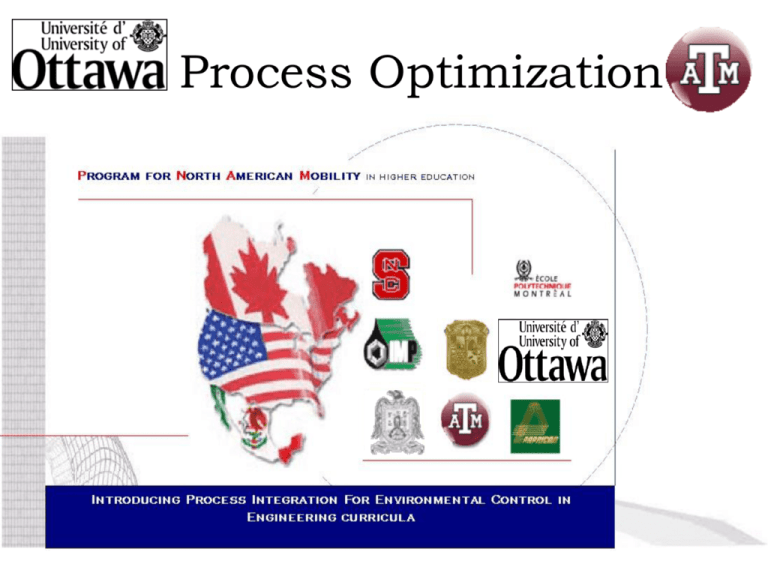
Process Optimization Tier II: Case Studies Section 1: Lingo Optimization Software Optimization Software • Many of the optimization methods previously outlined can be tedious and require a lot of work to solve, especially as models get more complex and move beyond two or three variables, which will often be the case • Software can be used to solve these problems more efficiently Optimization Software • Software that is available usually uses the same methods previously outlined, but can of course perform the calculations quicker, allowing the effect of variations in the model to be studied more easily Optimization Software • Some optimization examples have already been shown using Excel • Another program, Lingo, will now be demonstrated • A trial version of this software can be downloaded at www.lindo.com/cgi/frameset.cgi?leftlingo.h tml;lingof.html Lingo • Lingo is a program designed specifically for solving optimization problems • It uses a syntax that is similar to what would be written by hand, or what would be used in Excel, not requiring variables to be declared • For example, y = 3*x^2 is y = 3x2 Lingo Operators • Many of Lingo’s mathematical operators are similar to what Excel uses: – Addition: + - Multiplication: * – Subtraction: - Division: / – For exponents: X^n – Equals: = – Greater than or less than: > or < • Note: Lingo accepts ‘<’ as being ‘<=’. It does not support strictly less than or greater than. Lingo Operators, con’t • Absolute value of x: @abs(x) • Natural log of x: @log(x) • Trigonometric functions: @sin(x), @cos(x), @tan(x) (x in radians) • Exponentials: @exp(x) • To return integer portion of decimal number: @floor(x) • @sign(x): returns -1 if x < 0, or else 1 Lingo Operators, con’t • Find max or min value in a set: @smax(x1,x2…,xn) or @smin(x1,x2…,xn) • To find maximum or minimum of a function: max or min • To allow negative variables: @free(x) • Lingo has a number of other operators, but these are the mathematical operators that are most likely to be used Using Lingo • Other operators, like logic operators, can be found in the help file’s complete list of operators • Now that we have the mathematical operators that are likely to be used, we can demonstrate how Lingo works with some examples • Lingo can be used strictly as an equation solver or as an optimizer Lingo Screenshot If additional help is needed Solve – to solve current problem set Basic Equation Solver This will find the intersection of the lines “y = 3x + 4” and “y = 5x + 1” Solution Note: Lingo does not distinguish between small and capital letters Equation Solver #2 Solution #2 Only one solution was found! There should be two solutions to this problem. The solver automatically stops when it finds the first solution. Solution #2 20 15 10 Y 7.791 5 3.2087 0 -5 0 5 10 -5 3.2087 X 7.791 15 Non-linear Difficulties • Lingo is not designed to deal with nonlinear equations • It cannot find multiple solutions • There is a problem with solving non-linear problems, especially if the solution is in the negative domain Maximum and Minimum • The maximum and minimum functions are the most important functions needed for optimization problems • These functions are used as follows: max = objective function; min = objective function; Solving Optimization Problems • Several optimization examples that were worked through in previous sections will now be solved using Lingo • The first example is from the introduction section Chemical Plant Example • Objective: Maximize 1000x1 + 1500x2 • Constraints: 4x1 + 2x2 <= 80 2x1 + 5x2 <= 60 4x1 + 4x2 <= 75 x1, x2 >= 0 Chemical Plant Example Lingo Solution Solution, including value of objective function at optimum and optimum point Transportation Scheme Problem Problem #2 Solution Negative Values • Lingo cannot automatically solve for a negative variable value • If it is suspected that a solution will be negative, then that variable will need to be specifically declared as free: @free(x); • It is a good idea to declare all variables like this, unless of course a negative value is infeasible Attempting to Obtain a Negative Solution • The following example will demonstrate what happens if a negative value is required to get an optimum solution • Lingo will automatically solve for the optimum solution obtained from only positive variables, even if this is not the true optimum Attempting to Obtain a Negative Solution Attempting to Obtain a Negative Solution This solution is viable if the variable values must be positive, but this is not the true optimum Attempting to Obtain a Negative Solution These statements allow negative values to be used for these variables Attempting to Obtain a Negative Solution Now the true optimum is obtained, with negative variables Greater Than or Less Than • Another potential problem that will be encountered using Lingo is that it treats < the same as <=, and > the same as >= • Thus, if a variable must be strictly greater than a value, the constraint is best treated as follows: – For x > A, where A is a solution otherwise, use x > A + b; where b is an arbitrary value, like 0.1, that covers a portion where the solution will not lie Example of < or > Example of < or > Clearly this is not correct as X1 was constrained to be greater than 0! Example of < or > This will now force X1 and X2 to be greater than 0. We can do this because we know X1 and X2 are also greater than 0.1. Example of < or > Variables now obey desired constraints. Objective just happens to be the same in this case. Conclusions • Lingo is effective and efficient for solving optimization problems if they are linear • It is not designed to deal with non-linear problems • It is not very good at dealing with non-linear problems, so these must be approached with caution • It does not handle multiple maximum or minimum points very well in non-linear cases


